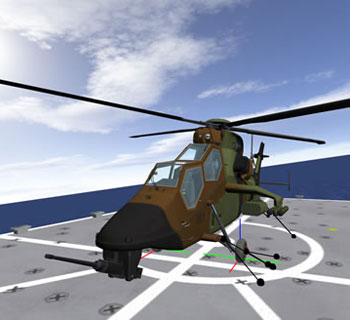Helicopter-Ship Interface software
As leaders in helicopter-ship analysis, we have developed powerful software modelling tools to estimate the Ship Helicopter Operating Limits (SHOL). These tools include AVT’s multi-body simulation software and the AVT-DST jointly developed OnDeck helicopter-ship interface software that has been in development since 1988. The OnDeck software has extensive automation to enable the determination of operating limits across a wide range of sea state and operating conditions. AVT also has other bespoke tools including a real-time virtual pilot capability for estimating flying limits during the ship landing phase.
Overview
Powerful operating limit and on-deck interface analysis
The OnDeck software is a multi-body non-linear time domain code, specifically optimised for the development of operational limits and the analysis of dynamic interface issues.
OnDeck incorporates accurate representations of the undercarriage and rotor system. It can model wheel sliding and lift off, the interaction with multi-contact surfaces, undercarriage loads, lashing loads, rotor and wind loads as well as the effect of restraint systems like MAMAS, MANTIS, RAST, ASIST, Decklock and the MacTaggart Scott TRIGON system. The helicopter models developed by AVT are accurate representations of the real helicopter having been developed from manufacturers’ data and parameter identification techniques using experimental test data.
PLATFORMS
Models for many helicopters

- S-70B-2 / MH60-R Seahawk (RAST, ASIST enabled)
- S-70A-9 Black Hawk
- SK 50/50A Sea King
- MRH90 / NFH90 (MANTIS and MAMAS Enabled)
- ARH Tiger
- Squirrel (ADF)
- Lynx Mk90b (Deck Lock and TRIGON Enabled)
- SH-2G Seasprite (Deck Lock Enabled)
- CH-47 Chinook
- S-92
- Bell 222
- A109
CAPABILITIES
Modelling for many scenarios
AVT commenced work in the area of helicopter-ship modelling in 1997 for the Australian Defence Science and Technology (DST) Group. AVT has been primarily responsible for maintaining, developing and validating the OnDeck software since 1997. During that time the capability has been continuously improved to the extent that it is now a mature proven product. Verification has been ongoing for the last 30 years and the use of the real time variant of the the software has validated specific helicopters models.
Helicopter Modeling
6 DOF fuselage rigid body with integrated multi-degree of freedom undercarriage models including drag links and multi-stage oleos
Non-linear oleo and tyre stiffness and damping models including hysteresis and polytropic effects.
Ship Motion Data Input
- Tilt table
- Sinusoidal 6 degree of freedom input
- SHIPMO7 frequency domain data
- FREDYN time domain ship motion data
- Experimental data
- IMU real time ship motion data (MHA System)
Tyre Contact Modelling
- Dynamic contact patch element methodology to capture both tyre adhesion and sliding
- Contact modelling based on tyre sectional properties enabling up to 85 deg combined lateral and longitudinal contact between the tyre and contact surface
- Multi surface tyre interaction enabling the interaction with ramps and other obstacles has also been demonstrated with an enhanced code.
Friction Model
Modified friction ellipse concept with tunable longitudinal and lateral friction coefficients for brakes on/off conditions, wet/dry deck conditions and static and dynamic motion.
Restraint System Models
- DeckLock / Harpoon with actuation model and limit load and gimble angle limit criteria.
- RAST / RSD model with limit load criteria. Traversable.
- ASIST model with limit load criteria. Traversable.
- MacTaggart Scott TRIGON system. Standby mode functional. Traverse / Render modes complete.
Wind Loads Model
- Lateral wind fuselage model only at this stage.
- 2D drag drag model is under development.
Rotor Loads Model
- Flapping blade element rotor model provides dynamic response characteristics as well as aerodynamic effects.
- Ongoing verification.
Lashing Models
- Non-linear models for chains, nylons and mitigators.
- Moving axle and drag link lashings modeled.
- Lashing failure mode capable.
Limit Conditions
- Wheel sliding.
- Wheel lift off.
- Lashing loads.
- Airframe tie down point loads.
- Ship tie down point loads.
- Undercarriage component loads (Landing analysis capable).
- Airframe / undercarriage clearance.
- Restraint system loads and or gimble limits.
- Relative motion position and attitude limits.
VIDEO GALLERY
AVT Helicopter-Ship Simulation
NH90 Deck Landing – Rapid Descent
OnDeck simulation of MRH90 helicopter with coupled MANTIS Deck Handler system.